
Hoarseness (dysphonia) in children
What is hoarseness (dysphonia) in children?
Such changes to the voice usually last a few days. However, repeated abuse of the vocal cords can lead to increasingly frequent episodes, or even constant hoarseness. The child will start to experience mild vocal fatigue, such as a sensation of tightness of the throat, and the hoarseness will eventually become permanent.
There are various causes of dysphonia in children. The main cause is abuse of the vocal cords; however, other factors can also play a role, such as respiratory infections, a history of hoarseness in the family, the child’s mood and psychological profile, and the vocal role models the child is surrounded by.
Different types of dysphonia in children include:
- organic dysphonia. This type of dysphonia has organic causes, such as congenital illnesses, cysts, chronic laryngitis, hormonal or neurological problems.
- functional dysphonia. This type of dysphonia is caused by poor vocal habits. An organic injury may also be involved, as poor vocal habits can cause changes to the mucous membranes of the vocal folds, leading to the formation of polyps, nodules etc.
There are various options for treating the pain:
- Medication will treat infections or inflammation of the ear and the larynx, which are very frequent in children. Antibiotics or anti-inflammatory medication will usually be prescribed;
- Surgery is necessary on rare occasions. The child will complete speech therapy exercises prior to the operation and will need post-operative rehabilitation;
- Speech therapy. After the child reaches the age of 4, parents usually receive advice or guidelines. From the age of 6 onwards, the child can start speech therapy.
 by Develona
by Develona